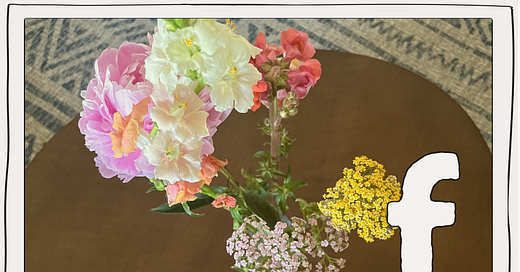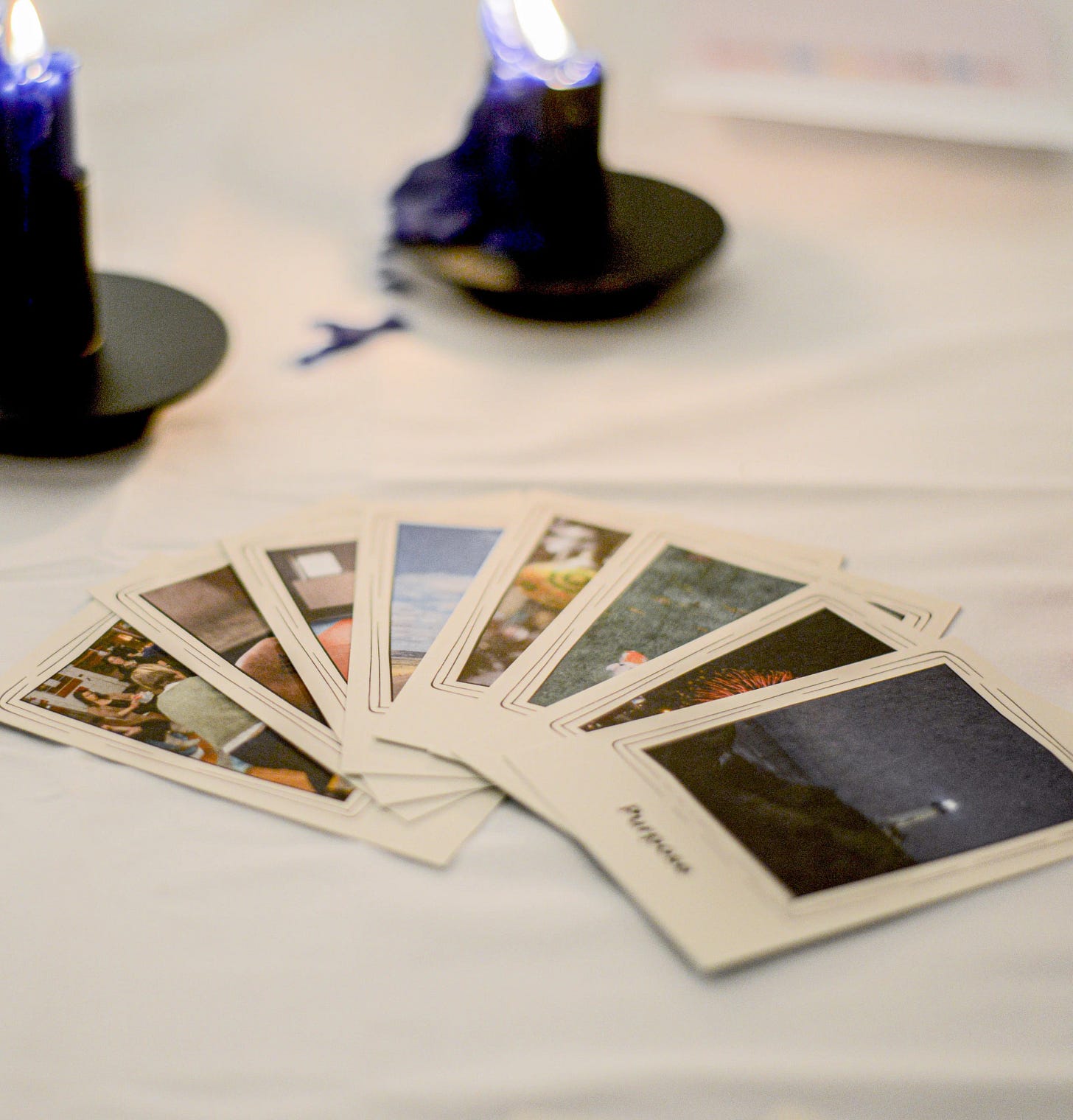At the farmer’s market this past weekend, my little one and I marvelled at the buckets of golden dahlias, bubblegum pink peonies, regal foxgloves, and oh so gleeful gladiolas. We put together a six-stem bouquet to take home at least one bunch of enchantment. My little one, Lilah, comes to know beauty through her hands and mouth — she grabs, squishes, licks, and chews her way through both the natural and manufactured world. By the time we returned home, the vibrant bouquet was no longer simply a marvel of the eye, but a culinary experience. As I filled a jug of water to keep the vibrancy alive for a few days longer, I was struck by how these six, impermanent flowers brought to life some of the big ideas behind flourishing lives.
How so?
In our last post, we introduced some of the theory and research on what makes up a flourishing life. Across the range of philosophical, theological, and social science traditions, what is clear is that flourishing cannot be reduced to a single dimension. It is more than life satisfaction or happiness. It is also more than employment and productivity. That tracks with our own learning. In the framework that our team co-developed with more than 60 folks living on and off the streets, a good life was also much more than a roof over head and food on the table — material things were enablers of, but could also be barriers to, what really matters: a deep sense of connection.
We can think of a flourishing life as an ever evolving six-stem bouquet, each stem representing connection to:
body and self
friends, family, and community
culture
land & ground
the sacred
the human project (a sense of purpose, agency, possibility).
Fresh flowers come and go. Blooms burst forth, wilt, return to the earth, and new buds spring up. So do the moments that make-up our lives. Rather than see flourishing as a permanent end state, it’s a continuous process of growing, appreciating, and passing. In this metaphor, we are the florists of our lives. Across our many seasons, we arrange and re-arrange our bouquets — some times admiring their beauty, other times gifting our bounty, sometimes grieving their loss, and still other times, cultivating what’s to come.
Learning how to operationalize these big ideas — flourishing as six kinds of blossoming connections, always in motion and ephemeral — is at the heart of one of our longest running prototypes, Curiko.
For folks familiar with our history, Curiko started life as Kudoz. Like Curiko, Kudoz was a platform connecting people with and without disabilities to experiences based on shared curiosities & passions. Unlike Curiko, Kudoz viewed change as permanent and one-directional. We talked about success in terms of the same outcomes for all: greater independence, meaningful employment, better mental health, and less stigma. These are all good outcomes. But, we’ve come to realize they are not things we can tick off a list and be done with. Nor are they outcomes that are valued equally. A flourishing life isn’t a life lived for someone else and what they deem important. It’s a life lived meaningfully, in pursuit of our values and in an ever unfolding relationship to what is inside, around, and greater than us.
As part of the social design team behind Curiko, I see our role as rigorously pursuing answers to three questions: how might we enable people to
(1) come to know & share their values
(2) be in relationship to what is inside, around, and greater than them
(3) find meaning & purpose?
Every frontline worker and manager is also part of a de facto social design team. Whether they know it or not, workers and managers are always designing and running social interactions. The question is what ideas are guiding the development and delivery of those interactions? That’s where I hope readers might play with some of the big ideas introduced in Spores & Sparks — ideas like individual & collective agency, the capabilities-opportunities-motivation (COM-B) framework, delight, and encounters. These are all ideas that can create the conditions for arguably the biggest idea of them all: flourishing. Here’s a few ways we’ve been blending ideas to lay a groundwork for flourishing lives.
How to enable people to come to know their values
To help people come to know their values, we start from the premise that values are distinct from activities or goals — which is often the focus of social sector intake and person-centred planning processes. What people do or want to do is different from who they are and want to be. So often our conversations stay at a surface level and don’t probe what shapes people’s purported preferences.
Take bowling: an activity that often appears in person-centred plans in the disability space. Behind a desire to go bowling could be a number of different values — for solidarity & belonging, competence & excellence, play & pleasure, status & reputation, or stability & tradition. And then there’s the question of whose values are at play? Our values are shaped by our contexts — by what we’ve been exposed to and what we think is expected of us. As we explored in ‘A is for Agency,’ individual choice & control is always formed & expressed within relationships. We find it’s helpful to map people’s network and their perceptions of what other people think is good for them versus what they think is good for themselves.
Sometimes, we do that using a version of our Values Card Deck: we ask people to pull out cards that other people (friends, family, staff) would pick for them versus those they would choose for themselves. Other times, we use sticker sheets and figurines.
Regardless of the tool we use, we find what’s most critical is how and where we engage in conversation— hosting conversations in staffed settings can change what emerges, as does being attached to the answers. As in, when we are able to be present and curious, rather than needing to extract certain information, or engage in pre-set activities, or move towards particular outcomes, it’s easier to peel back layers and get closer to the heart of what matters.
How to strengthen people’s relationship to what’s inside, around, and greater than them
Some of the best ways we’ve found to strengthen people’s relationship to their inner & outer worlds is through what we call taster experiences. Taster experiences are a kind of encounter — see ‘E is for Encounter’ — a short and often surprising interaction that takes people out of their usual routines & comfort zones just long enough to spark intrigue and desire.
We built the Curiko platform as a catalogue of taster experiences — some of which are one-off, and some of which turn into ongoing engagements. We often need a spark to figure out who we are and how we relate to what’s around us. That spark might be another person, a new setting or space, an object, prompt, or an invitation to play a different role than we usually do.
As we explored in ‘C is for Change,’ to change what we think, feel and do, three factors must converge: (1) opportunities to think, feel, and do differently; (2) willingness & desire; and (3) knowledge & skills. Over time, through plenty of trial and error, we’ve found the sequence of these factors matters. Creating opportunities for people to momentarily try on a new way of thinking or doing can be a catalyst to shift motivation and skills. This is different to how schools and social services tend to work where skill building, training, and/or action planning comes first.
How to foster meaning and purpose
Meaning isn’t something standardized or universal. What I find meaningful may be quite different to what you find meaningful. Often, we don’t know what’s meaningful in the moment. We are too busy living that moment. We make meaning after an experience has ended as we process what unfolded and check-in with our bodies, hearts, and minds.
A meaningful experience is very different to a satisfactory or enjoyable experience, which are often the standards we hold our services to. When we are asked to rate a service interaction, we’re often thinking about whether it was easy versus hard, helpful versus unhelpful, friendly or rude. We’re not always thinking about whether it resonated — as in, whether it was beautiful, struck a chord, sparked insight, got us out of a rut, opened-up possibilities, helped us to feel less alone, etc.
This is one reason why we’ve built a coaching function into Curiko and tested so many different ways to foster individual & collective reflection. Coaching is one space for making sense of our experiences and learning about what does really matter to us — using lots of different modalities, be it poetry, body movement, photography, art journalling, etc.
We’ve also experimented with a range of ways to gather ‘meaningful’ or ‘significant’ moments on and off the Curiko platform - everything from video & text message prompts after an experience to in-person evaluative chats.
One of our biggest challenges is how not to ascribe our own meaning to a moment. It’s very easy for our team’s interpretations of meaningfulness to shape what moments we see and write down. It’s why we encourage any story written by a team member to be returned to the featured community member to get their sense of what mattered and why.
In the months to come, we’re going to try a story gathering tool we’ve used in Edmonton, as part of another prototype called Auricle, that regularly solicits short oral stories from people, asks them to do the interpretation, and invites participation in the synthesis process. Over the years, we’ve gone in and out of a practice of convening community members to read each other’s stories and participate in sense-making. But, it’s a practice worth reviving because collectively exploring what makes a moment meaningful is itself a route to experiencing more meaning. As we keep re-learning, sustaining a flourishing bouquet is a never-ending practice, one we must continually refresh.
So, what makes up your flourishing bouquet at the moment? How are you coming to know your values, learning to be in relationship with yourself and others, and finding meaning & purpose? What about for the people you care about and support?
F is for Flourishing Bonus Prompt
We can think of a flourishing life as an ever changing bouquet of flowers, with each stem representing a different type of connection — to 1) body and self, 2) friends, family and community, 3) culture, 4) land & ground, 5) the sacred, and 6) the human project - a sense of purpose, agency, possibility.












